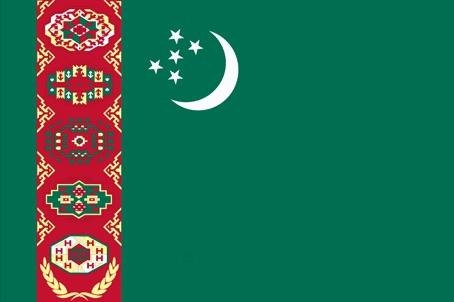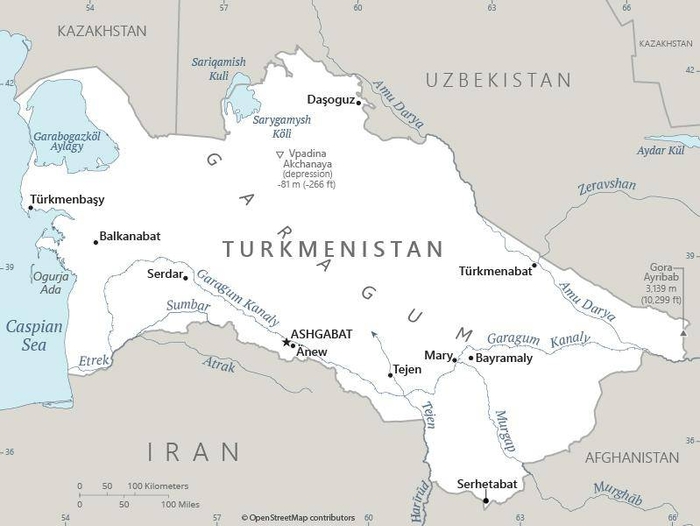172 Turkmenistan

Green field with a vertical red stripe near the hoist side, containing five tribal guls (designs used in producing carpets) stacked above two crossed olive branches. Five white, five-pointed stars and a white crescent moon appear in the upper corner of the field just to the fly side of the red stripe. The green color and crescent moon represent Islam. The five stars symbolize the regions or welayats of Turkmenistan. The guls reflect the national identity of Turkmenistan where carpet-making has long been a part of traditional nomadic life.
Flag courtesy of the CIA World Factbook

Map courtesy of the CIA World Factbook

Colorful market in Ashgabat.
Photo courtesy of the CIA World Factbook
Government
According to Britannica, Turkmenistan adopted a new constitution in 1992, replacing the Soviet-era constitution that had been in effect since 1978. The new constitution established legislative, executive, and judicial branches of government, dominated by a strong executive. The president, the head of state, was to be elected for a maximum of two consecutive five-year terms, but Turkmenistan’s first president, Saparmurad Niyazov, extended his term to 10 years in a 1994 referendum. A People’s Council (Khalk Maslahaty), made up of the president, members of the parliament, regional representatives, chairmen of the high courts, the cabinet, and other officials, had the authority to call national referenda, plan economic and social policy, and declare war. Despite having significant de jure powers, this council largely functioned as a rubber stamp for Niyazov’s decisions.
After the death of Niyazov in 2006, his successor, Pres. Gurbanguly Berdymukhammedov, led efforts to reshape Turkmenistan’s government while retaining the overwhelming presidential powers wielded by his predecessor. In September 2008 the Khalk Maslahaty accepted a new constitution that established a multiparty system and saw to the council’s own dissolution. Under the 2008 constitution, the powers previously held by the council were nominally divided between the president and an expanded unicameral parliament (Mejlis), whose 125 members are elected by territorial districts to five-year terms. The president was elected by direct popular vote to a five-year term. This provision was amended in 2016 at Berdymukhammedov’s urging to extend the length of a term to seven years. The president is empowered to appoint governors and mayors and may dissolve the legislature only in the event that the Mejlis is unable to select a speaker.
The Khalk Maslahaty was reconstituted in 2021 as the upper legislative chamber in a bicameral parliament (Milli Genesh). It consists of 56 members, 8 chosen by electors in each welayet, 8 chosen by electors in Ashgabat, and 8 directly appointed by the president, and has the power to approve legislation passed by the Mejlis, call referenda, and confirm presidential appointees to certain offices.
The country is divided into five welayats (provinces): Ahal, Balkan, Daşoguz, Lebap, and Mary. Ashgabat, the capital city, is administered independently of any welayat. The welayats are further subdivided into etraps (districts).
Civil / National Aviation Authority (CAA/NAA)
The Civil Aviation Agency (CAA) of Turkmenistan was created on 1/29/2019. The Agency is responsible for:
- Ashgabat International Airport;
- Turkmenbashi International Airport;
- Turkmenabat International Airport;
- Mary International Airport;
- Dashoguz International Airport;
- Joint Stock Company “Airline” Turkmenistan”;
- Main Air Agency;
- Aviation Training School; and
- Hotel Laçyn
Airspace
SkyVector – Google Maps – ADS-B Exchange
ICAO countries publish an Aeronautical Information Publication (AIP). This document is divided into three parts: General (GEN), En Route (ENR) and Aerodromes (AD). ENR 1.4 details the types of airspace classes they chose to adopt from classes A through G. Turkmenistan AIP

Drone Regulations
Currently, there is no legal framework for the use of drones.
Advanced Air Mobility (AAM)
Short Essay Questions
Question 1
You have been hired by a Drone Startup Company. Your boss has immediately assigned this job to you.
They need you to prepare a one-page memo detailing the legalities of using a drone to film tin Ashgabat, pictured above.
They need you to mention any national laws and local ordinances.
They specifically want to know what airspace you will be operating in and whether or not you need an airspace authorization.
Does it matter whether or not you are a citizen of the country?
Lastly, there is a bonus for you if, as you scroll through this chapter, you find any typos or broken links!
Question 2
Do you need a certificate to fly UAS?
If so, how do you obtain one?
Are there fees associated with this?
If so, how much?
Question 3
May you operate beyond visual line of sight?
If so, what procedures must you follow?
Question 4
Does the country have UAM/AAM laws? If so, describe, citing the exact law.
Question 5
Are you aware of any new laws or policies not mentioned above? If so, describe, citing the exact law or policy.

